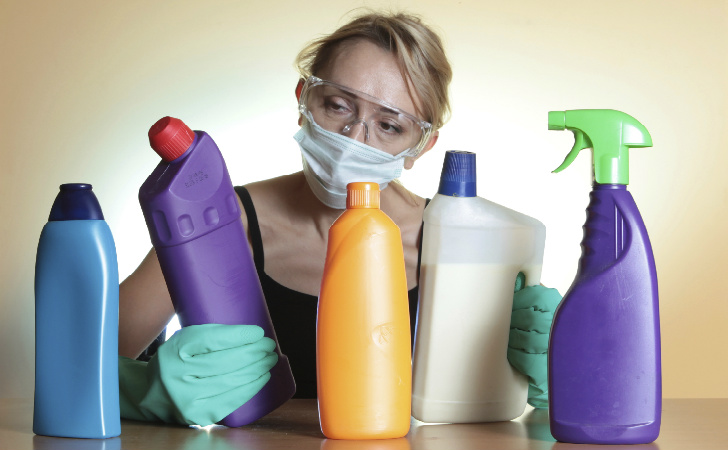Dangerous Cleaning Products That Need to Be Removed
You’d figure that consumer safety regulations have your back, right? In reality, companies that develop household products have very few labeling requirements and don’t need to disclose their ingredients. For chemicals in non-edible consumer goods, the motto is ‘innocent until proven guilty.’ The Toxic Substance Control Act is structured so that there must be solid proof of a new chemical’s negative effects on human health or the environment in order to regulate it.
In 1995, The National Toxicology Program concluded that somewhere between 5% and 10% of all chemicals in production could be expected to be carcinogenic in humans. That’s 4,000 to 8,000 different chemicals, almost all of which remain unregulated.2
It’s been demonstrated time and time again (think DDT and BPA) that just because a chemical doesn’t have immediate negative health effects doesn’t necessarily mean it’s safe in the long term. Cancer, birth defects, and many other adverse health symptoms could be delayed over a lifetime or even passed on epigenetically (the influence of environmental factors on gene expression), affecting your children’s children.
Health advocate Mark Sisson says, “The chemicals we so liberally spray, wipe, spread, and apply present an unnecessary risk. With so many effective, cheaper alternatives out there, it just makes sense to choose safer options.”3
When it comes to deciphering the safety of cleaning products, you should be the one determining the regulations for you and your family.
We’re beings that are designed to interact with our natural world. There are a multitude of complex pathways that allow our biology to converse with its environment. However, when you throw synthetically-derived chemicals and other questionable substances into the equation, it becomes difficult for our bodies to navigate. Here are a few ways in which toxic chemicals begin to engage with our biochemistry:
Skin is often thought of as a barrier between you and the outside world, but that’s just not accurate, as you’ve learned by now. Yes, it serves to protect you, but it’s also a permeable membrane that’s designed to both absorb and excrete.
Your skin doesn’t have a perfect filtration system that is able to discriminate against toxic chemicals. Chemicals in cleaning products can be readily absorbed through it, at which point they have access to your entire body.
Another way that they gain access to your internal environment is through the respiratory system. Aerosols and other cleaning sprays can leave trace particles in the air that oxidize into harsh pollutants. The confined nature of indoor space matched with a lack of ventilation can lead to high levels of these toxins lurking in the air, which can contribute to breathing problems, asthma, or a compromised immune system.
One of the most significant systems that can be affected is the endocrine system, which regulates our hormones. These vital substances act like messengers within our bodies. They’re responsible for taking external cues from the environment and sparking the body into action. Everything from sleep to weight gain can be influenced by hormones.
Many chemicals have been known to mimic certain hormones (molecular mimicry), which can cause your body to get its signals crossed. This can lead to a wide range of symptoms that are hard to trace, as they often take time to manifest into disease. It sometimes takes years or even decades to connect a specific chemical with a hormonal effect.
Onto the list…

1. Air Fresheners
When it comes to freshening up your home, you may want to reconsider using air freshener altogether. Even the most “natural” air fresheners are some of the worst culprits when it comes to unsafe ingredients. Watch out for some of these ingredients in other types of surface cleaners or disinfectants as well.
Fragrance: There are thousands of chemicals that can fall under the category of “fragrance.” This is one way for companies to sneak toxic ingredients (many of which are classified as hazardous by law) into their products without alerting the consumer. Most of these chemicals contain volatile organic compounds (VOCs) that are known to have adverse health effects, especially when released into the air.4
Phthalates: This is one ingredient that can be found in “fragrance.” These are known endocrine disruptors and are linked to premature birth, male feminization, and infertility in men.5,6
Aerosol/Sprays: According to one report, 20 million people suffer from asthma in the US—a number that has increased steadily in the past few decades. When products are sprayed indoors, they oxidize and cause a chemical compound that is essentially smog, which is known to cause breathing conditions.7,8
Alternatives: Nothing beats the essential oils of real herbs and plants. You can find wide ranges of different types, from sweet citrus to earthy scents, at your local health food store. Make sure they’re 100% essential oils and nothing else. Find a few that you like and dilute a few drops in a spray bottle of distilled water. Cinnamon, mint, and tea tree are a few that make great bathroom deodorizers.
Baking soda can also be used to absorb foul smells. Simply leave an open box in the fridge or sprinkle it over an area, let it sit for an hour or so, and then vacuum. Many houseplants are known to provide air filtration. According to NASA, rubber plants, English ivy, peace lilies, spider plants, and members of the Philodendron and Dracaena family are the best at filtering toxins from indoor spaces.46

2. Antibacterial Products
More and more research is bringing to light the fact that our obsession with obliterating germs may actually be doing more harm than good. Our attempts at decimating bacteria are disrupting the microbiome, creating resistant strains and compromised immune systems. Many of the chemicals involved with these products pose additional health and safety risks. Check things such as dish soap, disinfectant sprays/wipes, bathroom cleaner, and other surface cleaners for the following ingredients:
Triclosan: This is a biocide that works by deactivating an enzyme in cell walls, and has been shown to lead to resistant mutations in bacteria otherwise known as “superbugs.” You could very well be creating a robust army of bacteria that eventually marches right through and gets you much sicker than its weaker counterparts.
Under some conditions, triclosan is also able to convert into dioxin, which is one of the deadliest known pollutants. In addition, it may also pose toxicity issues for the immune system and sensory organs.9 Triclosan sometimes goes by the name Microban and can be found in everything from cleaning products to clothes and children’s toys.
Quaternary Ammonium Compounds: Another substance shown to create resistant bacteria, QAC has also been found to have toxic effects on marine habitats. It’s associated with asthma in humans and possible birth defects in rodents.10,11
Alternatives: There are plenty of simple alternatives that serve as effective disinfectants: alcohol, hydrogen peroxide, vinegar, or hot water and soap. Some essential oils (neem, lemon, oregano, helichrysum, and tea tree (melaleuca)) are also known to have antibacterial effects.

3. Glass Cleaners
It’s a good idea to keep an eye on the ingredients in all the surface cleaners you use, but glass cleaner is going to be the one you want to tackle first. In order to capture the streak-free shine, companies add solvents that cause chemicals to evaporate rapidly.
Once evaporated, these compounds are able to easily enter your respiratory system and can cause damage to the lungs and other organs. They can also stay in the air for extended periods of time when used indoors. Products like Windex and even some seemingly natural products like Simple Green have been known to include some pretty nasty stuff, such as:
2-butoxyethanol: This is a solvent that is responsible for the smell in many glass and other surface cleaners. It’s a confirmed carcinogen in animal studies, and prolonged exposure is linked to liver and kidney damage. It’s most toxic to the circulatory (cardiovascular) system and can even induce anemia.13,14
Ammonia: Repeated exposure can cause chronic bronchitis and contributes to asthma. Ammonia is also known to interact with other chemicals in the air and increase the amount of harmful indoor pollutants.1
Alternatives: Dilute rubbing alcohol or vodka with water. Alcohol is a helpful addition because it evaporates quickly to avoid streaking. You can even add a few drops of essential oils to give it a more pleasant scent! Vinegar-based solutions also work well.
Trending Articles
Zach Efron and Sami Miro Going Strong
Tabloid in long-form, Anger details the scandals of Tinseltown’s very first stars (including Rudolph Valentino, Roscoe Arbuckle, and Clara Bow) against the backdrop of a city charged by rampant debauchery and high glamour. Read More…
Twice-Cooked Bacon is the Best
The soup is great on its own, but it’s extra tasty with scoops of pesto that I made out of the carrot tops. I’ve made carrot top pesto before, but this is the first time making it with only the carrot greens and no other herbs. Because who has basil this time of year? Read More…
How to Manage God-Given Curly Hair
Your eye color is suddenly translucent, cheeks are flushed, there is soft rosy halo around your lash line, and your lips…your lips deepen as blood rushes through them and creates a beautiful, tragic look. This lip happens to work well for day or evening and doesn’t require you to cry! Read More…




